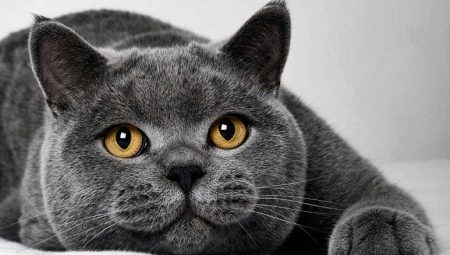The British cat breed is by far one of the most popular worldwide. Such animals are highly valued not only for their extremely attractive appearance, but also for a very pleasant character. Moreover, the uniqueness and aristocracy of this breed requires that its representatives be looked after in a special way - suddenly a regally beautiful animal needs some unusual care.
If you have been interested in the opportunity to have such a pet for a long time, our short excursion will certainly help you finally decide whether this is a good choice specifically for you.
Origin history
It is impossible to find an exact answer to the question of where the modern British cat came from - today there are at least two versions. The first of them says that cats, by that time already domestic and pretty pretty, were brought to the British Isles two thousand years ago by the Romans. At that time, the Roman Empire was already a developed civilization, and the colonial administration insisted on bringing domesticated animals from the south, effectively taking care of the preservation of the barns from the invasion of mice.

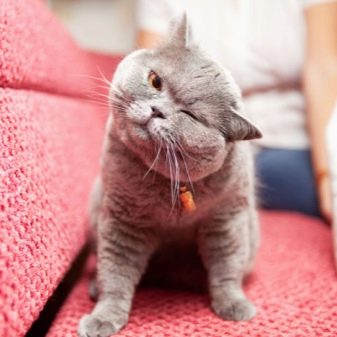
Another version is more prosaic and less common - according to it, the future "Briton" arrived from France, on the ships of the merchant fleet.
The sailors were not going to intentionally export animals to the islands, they just brought them with them for the same purpose - to protect ship provisions from unwanted eaters, but apparently, such pets sometimes escaped at the destination port.
Howbeit, in modern Britain, cats have been found for many centuries, however, for a long time cats were not considered decorative. They moved to people's homes relatively recently - before that they were, at best, kept in barns, that is, where they were most useful.
Only in the century before last, the British breeder Harrison Fair noticed that even street, stray individuals, despite all the vicissitudes of life, still look pretty good.
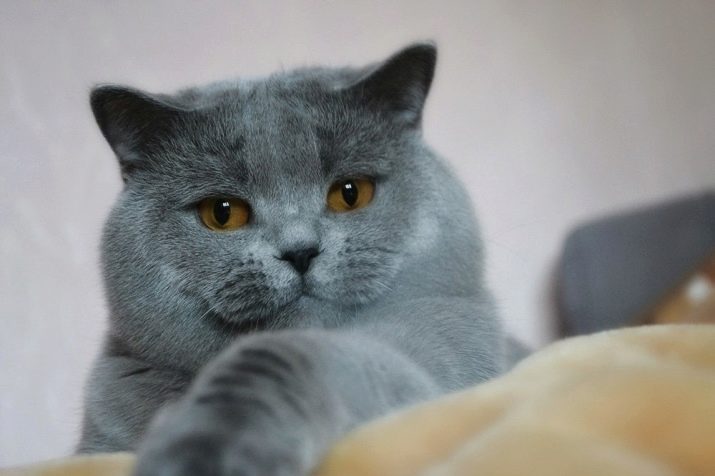
For many years, this man selected the most beautiful and healthy kittens, until in 1871 a new breed came to the exhibition of decorative cats. The British immediately gained some popularity, and a few years later they developed common principles for classifying the animal in this breed. During the Second World War, these handsome men almost sunk into oblivion, because the British were not up to their deliberate breeding.
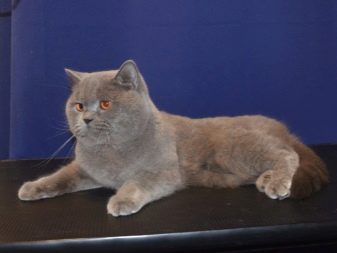
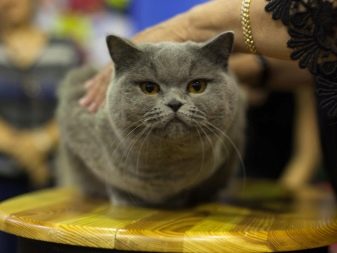
Therefore, it was even decided to cross the remains with Persian cats for the sake of the breed's survival. As a result, the modern Briton has somewhat changed in appearance, but has acquired a useful calm, coupled with composure.
In our country, the first British cats appeared in the last century, but at the peak of popularity, they began to climb only in recent decades, and it is possible that the bright future of this breed is yet to come.
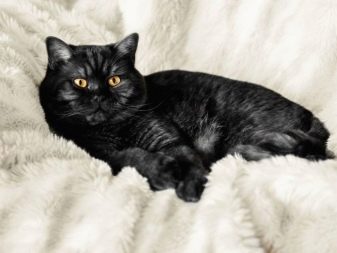
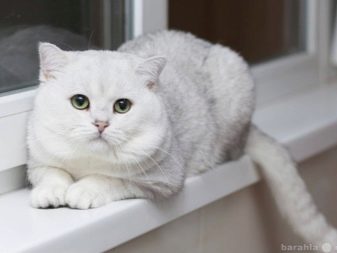
Description
Despite the great popularity of the breed, it is absolutely impossible to say exactly what its typical representative looks like, it is affected by the street origin of the animal and the presence of impurities.
Despite the fact that the characteristic does not provide for one specific color, specialists nevertheless accurately identify the real British. Let's see what features they are guided by.
The head of such an animal is set low, there is practically no neck. The correct shape of the muzzle of a thoroughbred pet is almost perfect round, such a cat has well-defined cheeks and, as it were, smiles. The cat’s nose is short, has a considerable width and a neat straight, has a small indentation in the nose. The ears of the mustachioed four-legged are low, they are far removed from each other, which is a clearly visible distinguishing feature.
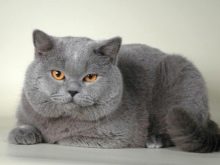
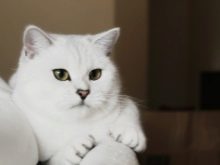
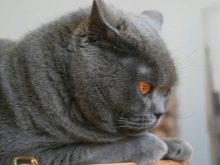
Large and clean eyes of a round shape, set at a considerable distance from each other, complement the look of a handsome man. As in the case of the color of the coat, the color of the eyes may vary significantly, but is usually considered correct if the shades coincide in many ways.
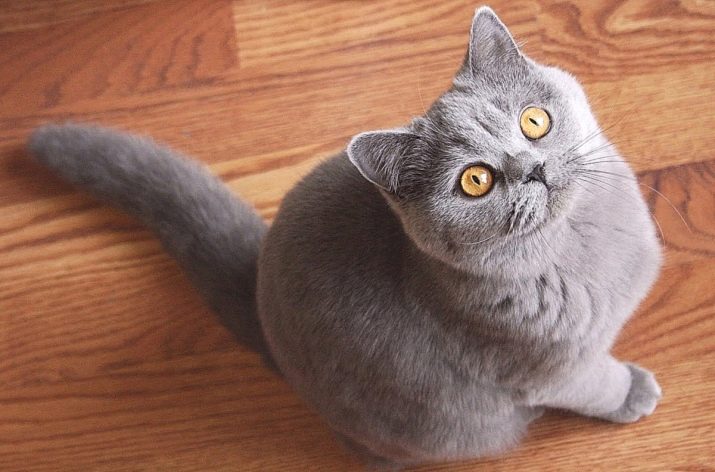
The British are considered to be strong in the world of cats, they are quite muscular and strong. The limbs are relatively short in length, but endowed with a certain physical strength, because of which such a predator in a jump can land on only three legs, the fourth attacking the selected victim along the way.
Kids grow and gain weight for a long time - it can take 3-5 years for a young individual. This is not surprising, because the body weight of an adult cat is 5-8 kilograms, while a cat is only slightly lighter - 4-6 kilograms. The body of any Briton is crowned with a rather short tail, which tapers closer to the base.
It should be noted that the concept of a British cat does not yet indicate the breed, since there are usually two that stand out: short-haired and long-haired. There is no fundamental difference between the two varieties, except what is displayed in the name. Moreover, long-haired animals actually have medium-long hair, they are very fluffy and attractive, but their breeding completely eliminates extraneous impurities, except, perhaps, for short-haired relatives.

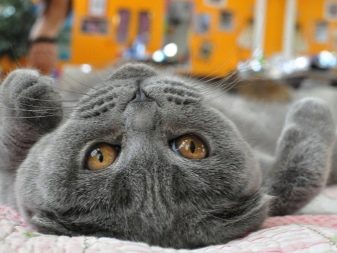
Character Features
In general, the character of a British cat is typically feline - all those stereotypes that we know from literary works fit this animal. First of all, this is a rather good-natured creature - it is cute not only in appearance, but also in its basic habits.In relation to the owner, such a beast is very affectionate, but at the same time knows the measure - not being too annoying, the pet at the same time likes to be in the room where its owner is located.

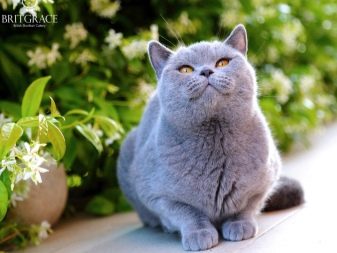
In relation to the guests, such a cat behaves somewhat differently. At home, he always behaves independently, the presence of strangers does not particularly bother him - it would be strange for a Briton to be shy of someone being on his territory.
The pet does not show hostility to guests, but in general its attitude towards newcomers is clearly noticeable - they can both please the animal and arouse cold interest. If you came to visit and did not like such a cat, you can not count on his affectionate behavior - he will dodge any attempts to stroke him, and he will certainly demonstrate that he is independent and self-willed.
The aristocracy of the animal is also expressed in the fact that it is used to a certain respectful attitude towards itself. This is by no means a dog that catches every word of its master and gladly carries out orders - on the contrary, a British cat takes a commanding tone very negatively and, instead of expected execution, can demonstrate all her cat stubbornness.
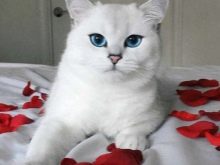
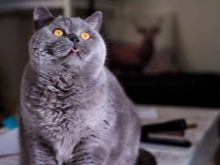

It is desirable to communicate with the pet in a friendly manner - then the probability of getting the desired result and not quarreling with your pet increases significantly. It should be noted that the cat is trying to choose for itself one owner, which for him is the maximum authority. The remaining family members are already less significant figures for him, and he will be less likely to listen to them.
British cats are self-sufficient - it will not be a problem for them if the owner spends a lot of time at work. They are able to wait and entertain themselves well.
At the same time, the pet does not go crazy while you are not at home - his calm nature does not allow the pet to make a mess in the apartment.
The same innate calm makes the breed very patient with children - despite the fact that the animal may not like too unceremonious attitude towards itself, it will not show aggression towards the child until the very end. Finally, even other cats and dogs, such a cat is quite tolerant.
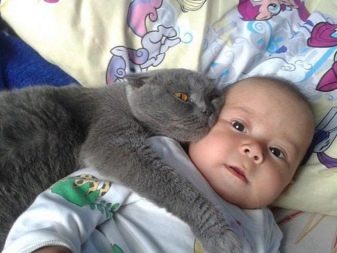
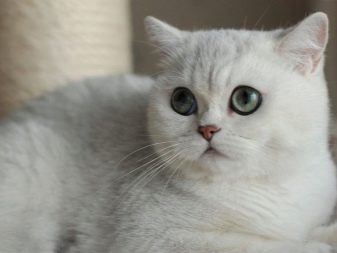
How old are cats?
Representatives of the British breed naturally have fairly good health, due to which they are less susceptible to various ailments, and therefore live on average longer. Another reason for the comparative longevity compared to other breeds is that modern representatives of the British have impurities of other breeds - this made it possible to ensure genetic diversity and once again protect pets from diseases.
The average life expectancy of the British is approximately 12-15 years, but this figure is only approximate. In practice, it all depends on the characteristics of the cat itself, and on how correctly he was looked after during his life.

In particular, if several long-livers are present in the pedigree of a thoroughbred individual, it is likely that your individual will reach the turn of 15 years. There are cases when representatives of the breed lived to 17-19 years.
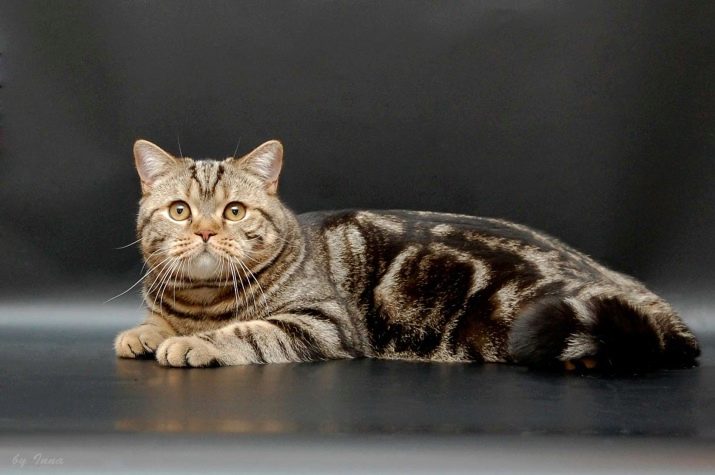
In any case, the correct content always allows you to extend the expected life of the pet. Scientists have long proved that neutered males and sterilized females live a couple of years longer - apparently, the body does not spend energy on the reproductive instinct, but at the same time does not suffer due to dissatisfaction with the instinct.
Also, stress in any form is extremely undesirable for an animal. Various injuries are a common cause of a pet’s early death, so it’s important to keep track of where the cat is walking.
In general, the extension of the life of the Briton includes five main tasks that the owner must perform with all severity:
- animal nutrition should be moderate, but at the same time timely, sufficient and balanced;
- the cat is a predator; for the normal state of the body, it needs constant movement; without walks, it can be choking;
- Cats do not have diseases that are treated according to the principle of “self-healing”, especially among healthy Britons - if you have any bad symptom, you should immediately contact your veterinarian;
- no matter how effective the treatment, it is better not to get sick and not to be treated at all - for this you need to conduct regular prevention of the main ailments, consisting in timely vaccination and some other procedures;
- it is worthwhile to ensure that the beast does not encounter any negative phenomena, whether it be boredom or an unfriendly attitude on the part of households - all this is stress, so dangerous for the animal.
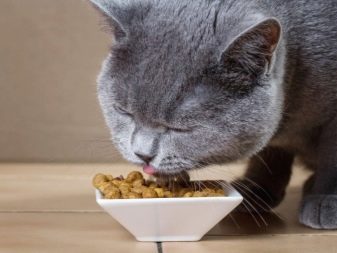
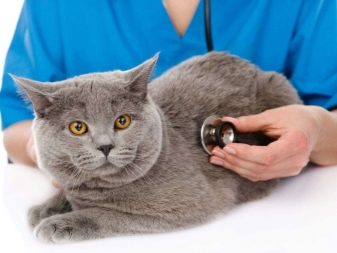
Kinds
Due to the fact that real British do not have too strict a description of their breed and are not devoid of extraneous impurities, it is rather difficult to determine what is a full-fledged breed and what is only a specific color. Varieties of the British breed in terms of coat color are numerous and diverse, because among them often separate breeds are distinguished, which are not recognized by all.
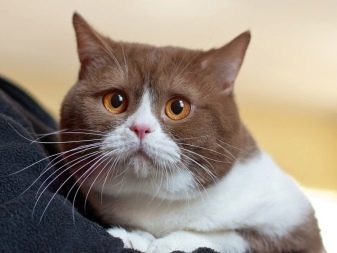
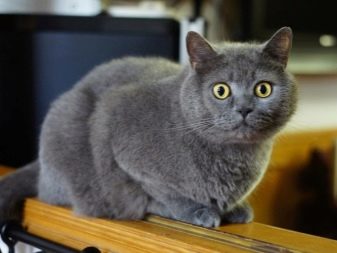
The main thing that should not be confused, so as not to offend another catman, is that British cats, contrary to the name, are rather English. The Scottish breed is considered completely separate, outwardly it does not at all look like the British.
The main difference between the British and the Scottish cat is that the first is erect, and the second is fold. In all other respects, these two breeds are very similar: here is the general fluffiness, and shades, and sizes. Because of this, an inexperienced person can easily be confused. In general, British cats can be divided into separate breeds except for the length of the coat, as mentioned above.

The color of the coat, like the color of the eyes, in most cases is not considered a sign of a separate breed - it is not so important, with blue eyes British, green or lavender, from this he still does not begin to be considered a separate breed. A relatively rare color can make a pet unusual and more interesting, but still this does not give grounds for its isolation in a separate subspecies.
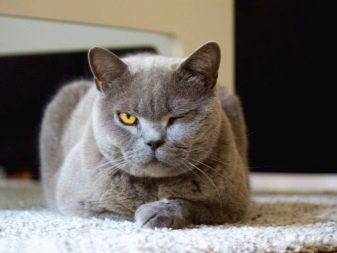
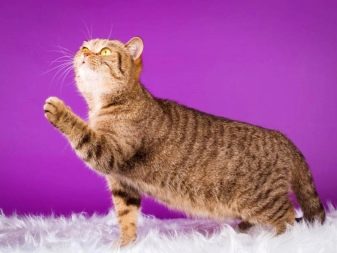
Content
Contrary to the expectations of some people without experience breeding cats, an exquisite Briton is not pretentious to care - his street origin affects. Almost all that is necessary to ensure normal maintenance is to take care of the hair in a timely manner, since this beast became a universal favorite precisely because of its beautiful fur coat.
To keep the coat soft, smooth and silky, it is necessary to comb out it carefully two to three times a week. A comb for these purposes is not suitable for everyone - you should buy a special brush-poduderka in a pet store. Such a tool has a massage effect, therefore, it not only helps to remove all excess hair, but also allows the animal to relax, and also stimulates enhanced hair growth, which makes the pet look even more beautiful.
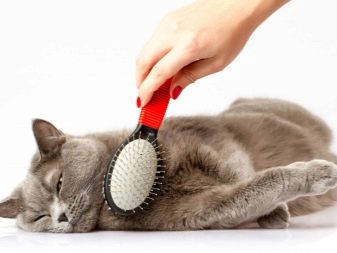
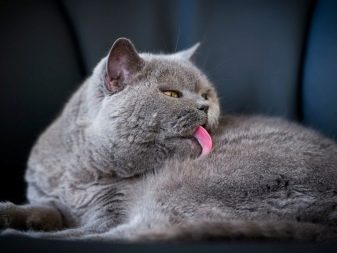
At the same time, it is not worth getting carried away with bathing a cat - for representatives of the shorthair species, two such procedures a year will suffice, unless the animal is soiled that it cannot be cleaned on its own. Long-haired animals are usually bathed as they become dirty, that is, somewhat more often.
The British’s claws are growing very quickly - practice shows that the efforts of only a claw’s nail can not cope with such a problem. For this reason, every two weeks, it is necessary to trim the claws, removing about half of the regrown length.
In the corners of the eyes of the pet, mucus can collect, which is a potential medium for the reproduction of various pathogens. Such secretions are removed using a moistened cotton pad, with gentle movements, in the direction of the nose.In addition, every two weeks it is necessary to inspect the pet’s auricles - if earwax or any other dirt has collected there, it must be removed by similar means. At the same time, it is advisable to moisten the cotton pads in a special solution, which can be bought at a veterinary pharmacy.
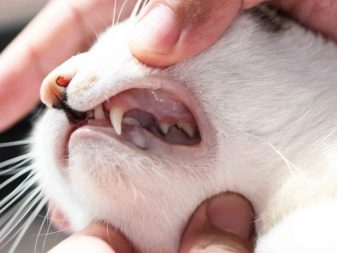
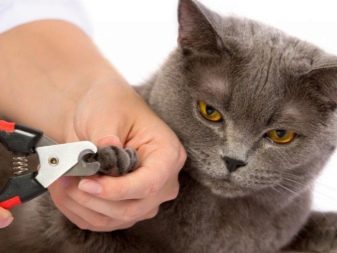
What your pet certainly won’t like is the need to examine the oral cavity daily for any dental problems. Experienced cat-catchers advise from a young age to accustom a kitten to the fact that every day they will brush their teeth with a special toothpaste - if such a procedure becomes a habit, it will no longer seem so unpleasant.
In terms of training, the British are pretty smart - at least you can train them to the tray quickly and without much effort. To do this, you need to monitor the kitten immediately after he has eaten - in the next few minutes he will begin to show some concern, showing that the baby is not against going to the toilet.
At this point, you need to grab it and carry it to the tray, and there it should be seated and not let go until all things are done. Pretty soon, the beast will remember the location of the latrine in the apartment, and will come there himself, just keep in mind that the cat is a clean animal, therefore a dirty tray will scare it away, and it will choose another latrine for itself.
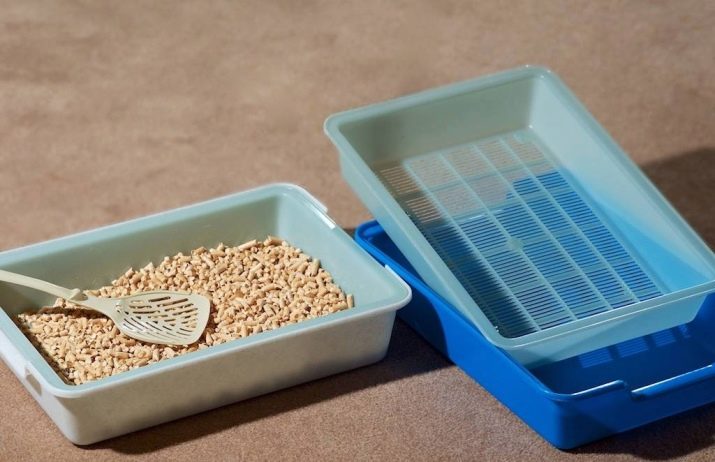
By the way, remember that the British are very proud. Having punished an animal for misconduct, you are unlikely to find understanding - the animal will not understand what the punishment was for, and simply considers you not a very good person, which can ruin the relationship between the pet and the owner. For this reason, after catching a pet for an indecent business, resort to the so-called remote punishment - instead of assault, shell the animal from a spray gun.
Over time, the cat will develop a causal association, and she will understand that she is doing something wrong, and you will not be perceived by her as an executioner.
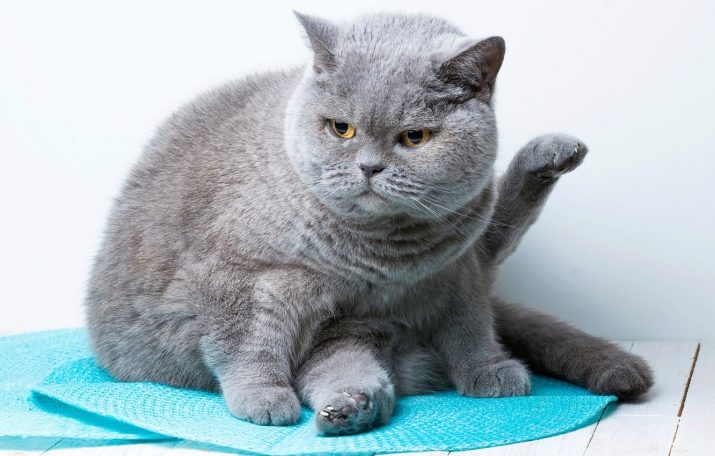
What to feed?
The attractive appearance and general health of the animal largely depends on how well it eats. The menu of a British cat is no different in principle from the correct diet of other cat breeds, therefore we simply repeat the truths well known to any experienced cat-cat.
First of all, the cat is a land predator, and although most cats will not refuse fish, it should not be the basis of their diet. Both store feed and a self-compiled diet should consist of about three quarters of meat products, best of all beef or poultry. It is not worth giving the animal too fatty meat, but if it comes to offal, then they can be obtained from any animal.

At the same time, you should not give the pet a whole piece of meat - although he is a predator, you should remember about the need to protect the pet’s teeth if you do not want his health to be spoiled.
About a quarter of the animal's diet can be side dishes - vegetables and cereals are well suited as such. Potato is a debatable product - some wallets do not recommend giving it, others indicate that they have never noted any special negative consequences.
It is believed that to supplement the daily menu with vitamins and minerals, the Briton should give a chicken egg weekly. In addition, periodically it is necessary to introduce fermented milk products, such as kefir, cottage cheese, fermented baked milk or cheese, into meals. Previously, cats had to be given the opportunity to walk on the street so that they would find the right greens, but today all the necessary substances can be purchased in tablet vitamins.

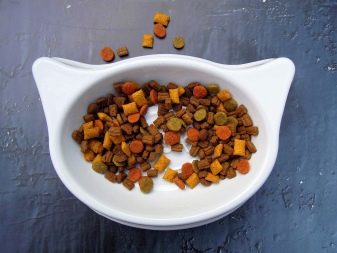
Dry food is allowed as the basis of the diet, but usually a requirement is put forward to them, according to which, the quality should not be lower than premium.A similar product is good in that it already contains everything you need, and in itself is a balanced diet, because with a mixed diet, the emphasis is usually placed on dry feed.
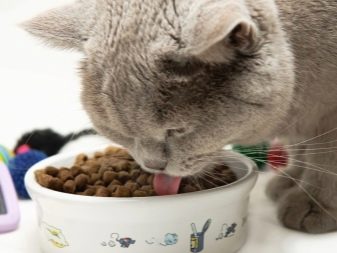

Whatever you feed the animal, you need to remember that it is undesirable to overfeed it - excess weight has not brought anyone to good.
For an adult animal, usually two meals a day are enough; babies are fed three to five times daily. It should be remembered that some products that seem normal to a person, and therefore falling into a cat's bowl, can often cause certain health problems for the pet. These include the following types of food.
- Milk. Despite the fact that many tetrapods do not refuse this product, they, like many other animals, develop lactose intolerance in adulthood. Apparently, this is the way nature protected baby food from adult abuse.
- Sweets. Thoroughbred cats are especially prone to obesity, and this statement applies to the British fully. In order to avoid problems with the cardiovascular system and motor activity, such treats are contraindicated for cats.
- Salt and spices. The abundant presence of seasonings negatively affects digestion, the same acids adversely affect the walls of the cat's stomach. Salt is often accused of another problem - it retains moisture in the cat's body, causing swelling.
- Coffee and alcohol. Everyone knows about the negative impact of these products on the human body - for pets they are just as dangerous.
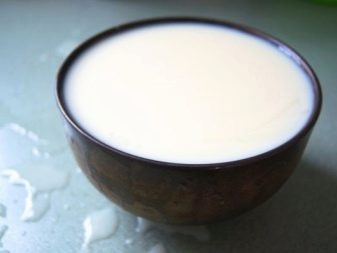
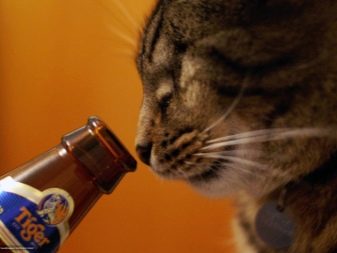

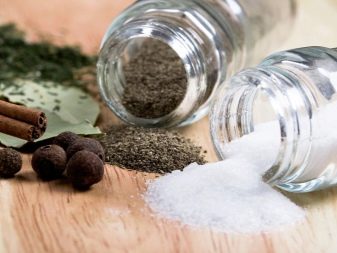
Breeding
A thoroughbred animal is often purchased for subsequent breeding in order to profit from the sale of kittens. In addition, many owners believe that this is much more humane than castration and sterilization.
A female British cat reaches puberty by about 8-10 months, but experts usually do not recommend immediately bringing her to mating - the young body is not yet strong enough to bear offspring, the consequences of haste may not be the best. Ideally, a cat ready for breeding, showing a serious interest in this, is taken to the cat for a visit. Her partner must be carefully selected.
To get thoroughbred kittens, you need to choose a representative of the same breed, they are also not advised to experiment with mating animals of different colors. Despite the fact that the British are usually distinguished by good health, it will not be superfluous to double-check how healthy the future father is.
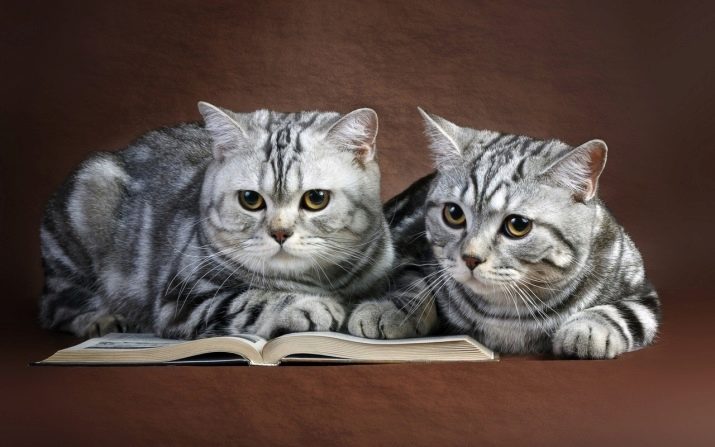
The process is not too fast - the typical cat courtship that can be heard under the window on a spring morning lasts about a day, during which time the guest gets used to the new place and gets acquainted with the future father of her children.
If the female is still very young, she may not get pregnant according to the results of the first mating, but usually this is not a reason for panic - you just need to wait until the next time and repeat the procedure.
A cat’s pregnancy lasts about two months, the easiest way to determine its beginning is by the hormonal background - the animal’s body, which received what he wanted, relaxes and calms down. After 15-20 days, such a sign of pregnancy as swollen nipples appears, the beast shows remarkable appetite. At this stage, the fish should be completely excluded from the menu of the expectant mother, but the proportion of sour-milk products should increase.
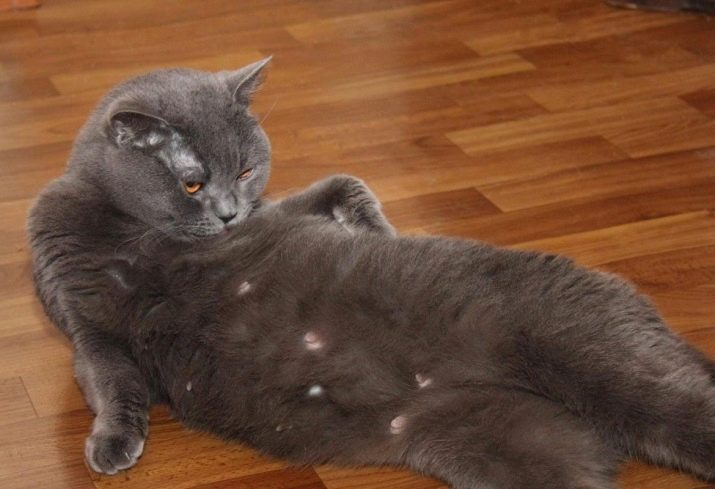
During the first one and a half to two months, the cat takes care of her babies herself, and nobody will do better than she does. After this period, when the kittens are gradually becoming more independent, they need to be shown to the veterinarian so that he prescribes a vaccination course and generally assesses their health status. In addition, thoroughbred babies right now need to make documents confirming their origin.
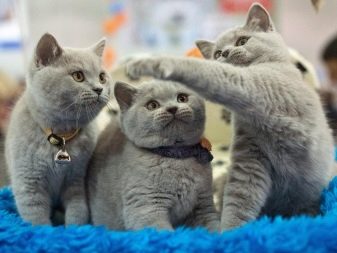

Interesting Facts
We will also please our readers with a set of interesting information about these beautiful animals:
- it is generally accepted that the Cheshire cat is copied from a representative of the British Shorthair;
- in total there are about 30 varieties of color, which are considered officially recognized and acceptable for the British, although most often they are recognized by gray-blue wool;
- Do not be surprised at the drowsiness of the animal - it is normal for him to sleep for 14-16 hours daily;
- representatives of this breed are distinguished by very quiet behavior - they almost never meow, unless they really need to attract the attention of a person;
- The “face” of the Whiskas brand is the representative of this particular breed;
- The special friendliness of such cats is that even in a game similar to wrestling, they usually do not release their claws, being careful not to harm the sparring partner.
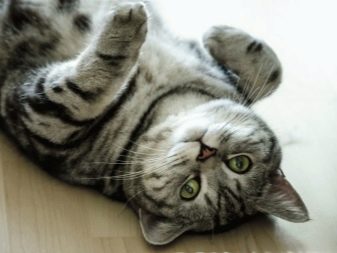
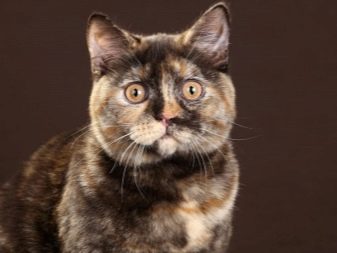
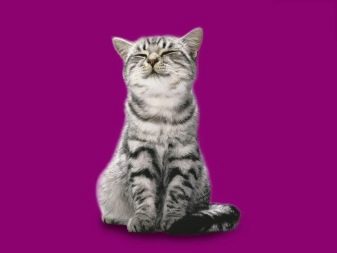
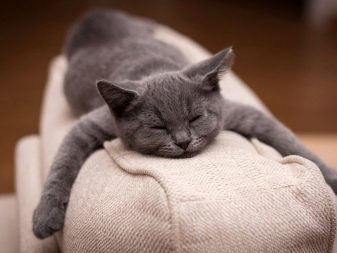
Owner reviews
British cats are often figuratively called "pets for businessmen", and this is the best characteristic of such an animal. He can be left at home alone with himself and left at almost any time, the main thing is to leave the pet enough food and water. In modern realities, where most people are sorely lacking time, this is the best pet.

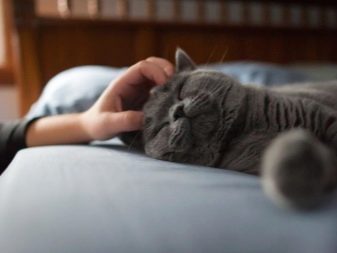
Despite the fact that the British respond well to education and training, they need to deal with these issues from the early childhood of a kitten, otherwise in the future it will not work to break the formed character of the four-legged personality.
Experienced cat-wizards are advised to first clearly imagine how you will keep and raise such a pet, and only then, when the picture is fully formed, acquire an animal. It will be extremely difficult to instill new habits for an adult animal, because the owner should be one step ahead of the development of the cat.
Aristocratic looking pets are usually worn in clothes, but if you decide to get one too, note that it should be comfortable and made from natural materials. The fabric from which the clothes are sewn should be easily washed and dried in a short time.

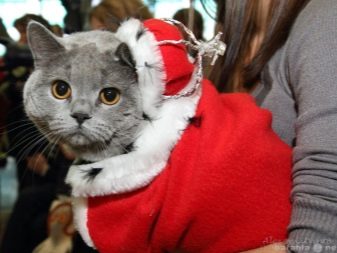
Interesting facts about British cats are presented in the video below.
